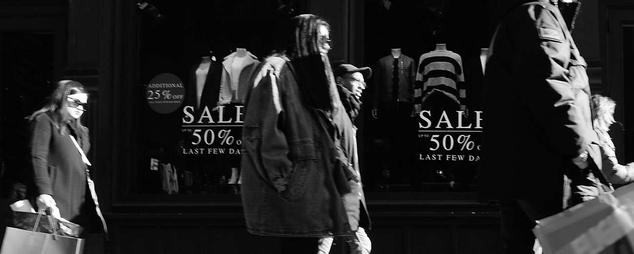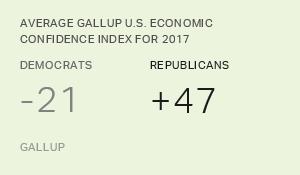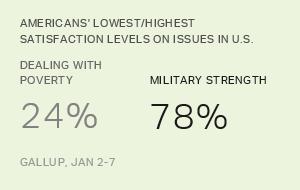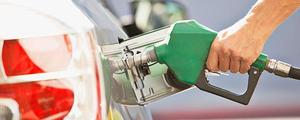Story Highlights
- Residents in most states more positive than negative about U.S. economy
- Top Economic Confidence Index score is +25
- Minnesota among top 10 states for ninth year in a row
WASHINGTON, D.C. -- Residents in three states -- Wyoming, North Dakota and Utah -- essentially tie as the most confident in the U.S. economy, based on their scores on Gallup's Economic Confidence Index throughout 2017. In contrast, Vermont residents were least confident.
| Index score | ||||||||||||||||||||||||||||||||||||||||||||||||||||||||||||||||||||||||||||||||||||||||||||||||||||
|---|---|---|---|---|---|---|---|---|---|---|---|---|---|---|---|---|---|---|---|---|---|---|---|---|---|---|---|---|---|---|---|---|---|---|---|---|---|---|---|---|---|---|---|---|---|---|---|---|---|---|---|---|---|---|---|---|---|---|---|---|---|---|---|---|---|---|---|---|---|---|---|---|---|---|---|---|---|---|---|---|---|---|---|---|---|---|---|---|---|---|---|---|---|---|---|---|---|---|---|---|
| Top states | ||||||||||||||||||||||||||||||||||||||||||||||||||||||||||||||||||||||||||||||||||||||||||||||||||||
| Wyoming | 25 | |||||||||||||||||||||||||||||||||||||||||||||||||||||||||||||||||||||||||||||||||||||||||||||||||||
| North Dakota | 25 | |||||||||||||||||||||||||||||||||||||||||||||||||||||||||||||||||||||||||||||||||||||||||||||||||||
| Utah | 24 | |||||||||||||||||||||||||||||||||||||||||||||||||||||||||||||||||||||||||||||||||||||||||||||||||||
| Idaho | 20 | |||||||||||||||||||||||||||||||||||||||||||||||||||||||||||||||||||||||||||||||||||||||||||||||||||
| South Dakota | 19 | |||||||||||||||||||||||||||||||||||||||||||||||||||||||||||||||||||||||||||||||||||||||||||||||||||
| Georgia | 12 | |||||||||||||||||||||||||||||||||||||||||||||||||||||||||||||||||||||||||||||||||||||||||||||||||||
| Nebraska | 12 | |||||||||||||||||||||||||||||||||||||||||||||||||||||||||||||||||||||||||||||||||||||||||||||||||||
| Minnesota | 12 | |||||||||||||||||||||||||||||||||||||||||||||||||||||||||||||||||||||||||||||||||||||||||||||||||||
| New Hampshire | 11 | |||||||||||||||||||||||||||||||||||||||||||||||||||||||||||||||||||||||||||||||||||||||||||||||||||
| Tennessee | 11 | |||||||||||||||||||||||||||||||||||||||||||||||||||||||||||||||||||||||||||||||||||||||||||||||||||
| Montana | 11 | |||||||||||||||||||||||||||||||||||||||||||||||||||||||||||||||||||||||||||||||||||||||||||||||||||
| Texas | 11 | |||||||||||||||||||||||||||||||||||||||||||||||||||||||||||||||||||||||||||||||||||||||||||||||||||
| Florida | 11 | |||||||||||||||||||||||||||||||||||||||||||||||||||||||||||||||||||||||||||||||||||||||||||||||||||
| Bottom states | ||||||||||||||||||||||||||||||||||||||||||||||||||||||||||||||||||||||||||||||||||||||||||||||||||||
| California | 1 | |||||||||||||||||||||||||||||||||||||||||||||||||||||||||||||||||||||||||||||||||||||||||||||||||||
| Louisiana | 1 | |||||||||||||||||||||||||||||||||||||||||||||||||||||||||||||||||||||||||||||||||||||||||||||||||||
| Hawaii | 1 | |||||||||||||||||||||||||||||||||||||||||||||||||||||||||||||||||||||||||||||||||||||||||||||||||||
| West Virginia | 1 | |||||||||||||||||||||||||||||||||||||||||||||||||||||||||||||||||||||||||||||||||||||||||||||||||||
| New York | -1 | |||||||||||||||||||||||||||||||||||||||||||||||||||||||||||||||||||||||||||||||||||||||||||||||||||
| Rhode Island | -1 | |||||||||||||||||||||||||||||||||||||||||||||||||||||||||||||||||||||||||||||||||||||||||||||||||||
| Illinois | -2 | |||||||||||||||||||||||||||||||||||||||||||||||||||||||||||||||||||||||||||||||||||||||||||||||||||
| Maryland | -2 | |||||||||||||||||||||||||||||||||||||||||||||||||||||||||||||||||||||||||||||||||||||||||||||||||||
| Delaware | -3 | |||||||||||||||||||||||||||||||||||||||||||||||||||||||||||||||||||||||||||||||||||||||||||||||||||
| New Mexico | -6 | |||||||||||||||||||||||||||||||||||||||||||||||||||||||||||||||||||||||||||||||||||||||||||||||||||
| Vermont | -13 | |||||||||||||||||||||||||||||||||||||||||||||||||||||||||||||||||||||||||||||||||||||||||||||||||||
| Gallup | ||||||||||||||||||||||||||||||||||||||||||||||||||||||||||||||||||||||||||||||||||||||||||||||||||||
Gallup's Economic Confidence Index has a theoretical range of -100 to +100, with a neutral score of 0. Vermont was one of only seven states whose residents were more negative than positive about the economy in 2017. In stark contrast, 45 states had net-negative evaluations of the economy in 2016. The vast majority of states also rated the economy negatively in prior years, including all states from 2008 through 2013, all but Minnesota in 2014, and 46 states in 2015. These state-level patterns reflect the nationwide improvement in economic confidence that has occurred since the 2016 presidential election.
Much of that improvement nationally was driven by more positive assessments by Republicans, and many of the current highest-ranking states in economic confidence are politically Republican. These include Wyoming and Montana, which each ranked among the 10 least confident states in 2016, when Barack Obama was president.
Minnesota is the only state to rank among the top 10 in economic confidence in both 2016 and 2017, and has done so each year since 2009, finishing first in 2012, 2014 and 2015. North Dakota had been a consistent top 10 finisher, but missed in 2016 for the only time in the 10 years Gallup has compiled economic confidence figures by state.
A larger number of states finished in the bottom 10 in both 2016 and 2017, including West Virginia, Louisiana, New Mexico and Vermont. West Virginia had been the 50th-ranked state in economic confidence every year since 2010, but now is tied for 40th.
Several bottom-ranking states this past year -- including California, Hawaii, Maryland and Rhode Island -- ranked among the top states in 2016 but were surpassed by most other states because their confidence scores did not improve in 2017. Massachusetts was the only other state that did not show gains in economic confidence last year, and it finished just outside the bottom 10 after ranking first overall in 2016 with an identical score of +2. On average, economic confidence improved by 20 points in each state.

On a regional basis, economic confidence tended to be above average in a cluster of states in the Northern Plains and Rocky Mountain regions of the country. Outside of those states, four in the South (Florida, Georgia, Texas and Tennessee) and one in the East (New Hampshire) had confidence scores that were meaningfully higher than the national average. Most of those are Republican states, but Florida, New Hampshire and Minnesota are usually key battleground states in presidential elections. The 11 states below the national average are more reliably Democratic, apart from West Virginia and Louisiana, with five of these in the East or Mid-Atlantic regions of the country.
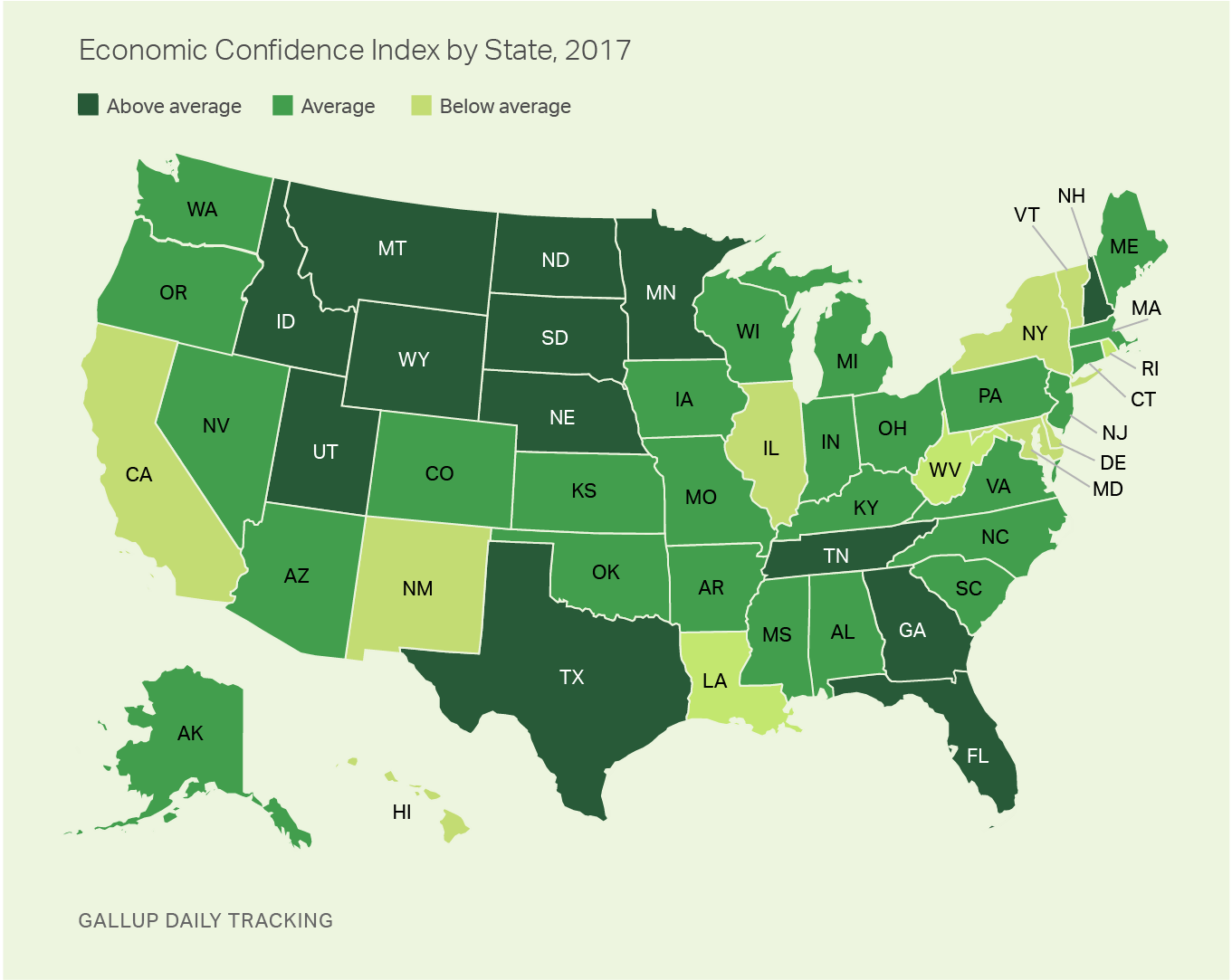
Gallup's Economic Confidence Index is the average of Americans' ratings of current national conditions and their assessments of whether the economy is getting better or worse. The full results for each state are available here.
Many of the states whose residents rate current conditions more positively are also among the most optimistic about the economy's direction. Likewise, states with lower ratings of current conditions also tend to be more pessimistic about the economy's outlook.
However, there are some exceptions to these patterns. Minnesota, Colorado, Washington and Texas are among the most positive about current conditions but not about the economy's trajectory. West Virginia, Louisiana, Arkansas, and Mississippi are less positive about the state of the economy, but those states do not rank among the most pessimistic about the economy's direction.
In these states, ratings of current economic conditions may be influenced more heavily by the state's economic situation at the time, while respondents' perceptions of whether the economy is getting better or worse may reflect their political leanings -- specifically their agreement with the President Donald Trump's economic policies.
Implications
Americans' views of the economy improved significantly last year, and this improvement occurred in all but five states. As a result, residents in 43 states now rate the economy positively, up from only five that did so in 2016. The improved confidence is likely a response to the bull market on Wall Street in 2017, further declines in unemployment, and the strongest growth in the gross domestic product in more than a decade.
Confidence in the economy is also influenced to a large degree by politics, with Americans' perceptions of whether the economy is getting better or worse shaped in particular by their views of the president and his policies. As such, residents in Republican "red states" tended to be more confident about the economy than those in Democratic "blue states" after the change from a Democratic to a Republican president.
But state and local economic conditions also affect residents' confidence in the economy. North Dakota and West Virginia are two prime examples of this, given North Dakota's recent oil boom and West Virginia's struggles because of declines in demand for coal. Republican-leaning North Dakota maintained relatively high economic confidence for most of the Obama years as well as in Trump's first year, and West Virginia -- despite having the highest approval ratings for Trump -- stayed among the least confident in 2017.
Survey Methods
Results for this Gallup poll are based on telephone interviews conducted in 2017, [on the Gallup U.S. Daily survey, with a random sample of 160,498 adults, aged 18 and older, living in all 50 U.S. states and the District of Columbia.
Margins of error for individual states are no greater than ±6 percentage points and are ±3 percentage points in most states.
All reported margins of sampling error include computed design effects for weighting.
Each sample of national adults includes a minimum quota of 70% cellphone respondents and 30% landline respondents, with additional minimum quotas by time zone within region. Landline and cellular telephone numbers are selected using random-digit-dial methods.
